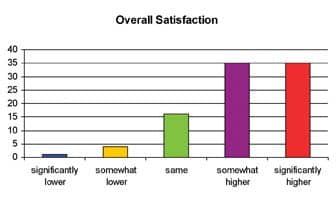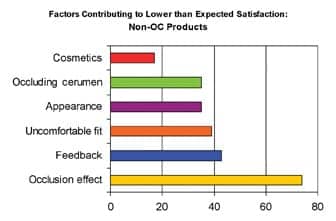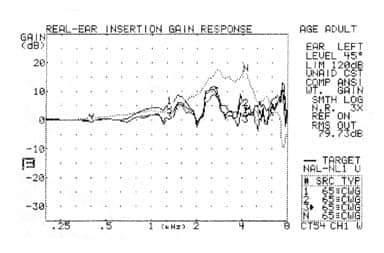
|
| Brian Taylor, AuD, is the global training manager for Amplifon SPA in Milan, Italy, and Lisa Berkeley, MA, is a training manager at Amplifon Inc, Plymouth, Minn. |
Survey and case studies from the real world
The popularity of open canal (OC) products has increased significantly over the past 2 years. As Figure 1 shows, the behind-the-ear (BTE) style has nearly doubled over the past 2 years.1 Although other factors (eg, directional microphones, improved cosmetics related to BTEs) may have played some part, the increase can be mostly attributed to the popularity of OC products among dispensing professionals.
It has been documented that professionals are very satisfied with the overall performance and quality OC products provide their patients. According to Johnson,2 the majority of audiologists surveyed have a favorable satisfaction rating for OC products when compared to non-OC products, with 62% of audiologists being more satisfied with OC products compared to non-OC products.
Although popularity within the audiology community does not equate to product effectiveness in everyday listening situations, there is some evidence suggesting that OC wearers enjoy some unique advantages, specifically better sound quality of their own voices, better localization, and improved cosmetics.3 Another study suggests that, for the proper candidate, there may be no downside to fitting OC products.4

|
| FIGURE 1. Percentage of total sales for each style, quarterly data. Source: Hearing Industries Association. |
Open Canal Survey
Given that OC products enjoy widespread popularity, the focus of the present study was to investigate whether OC products have any inherently unique problems in their design or use. In order to address this issue, we surveyed 92 dispensing professionals, asking them to share their experiences with OC products. All those surveyed are employed by Sonus and work in busy hearing aid dispensing practices around the United States and Canada.
Dispensers were asked what percentage of OC products they fitted annually. Results (Figure 2) show a relatively wide distribution of OC product selection, with a mean of 22% of OC-type products.

|
| FIGURE 2. Percentage of open fits per year (92 survey respondents). |
In order to better understand their use of OC products, dispensing professionals were asked to rate their overall satisfaction with them. Figure 3 shows that approximately 70% of those surveyed are more satisfied with OC products compared to non-OC products. These results are consistent with the findings of Johnson,2 and would offer further proof that the dispensing community is quite satisfied with the performance and benefits that OC devices provide.

|
| FIGURE 3. Overall satisfaction reported by professionals. |
Two separate questions were asked:
- Which factors contribute to lower than expected patient satisfaction for users of OC products?
- Which factors contribute to lower than expected patient satisfaction for users of non-OC products?
For both questions, respondents were asked to select from the following list of factors, choosing all that apply.
- Acoustic feedback
- Occluding cerumen
- Uncomfortable physical fit
- Occlusion-related problems (poor sound quality of user’s own voice)
- Cosmetics/appearance
- Ineffective in noise (no improvement with speech intelligibility in noise)
- Inability to insert or remove hearing aid
- Poor sound quality
A comparison of the responses is shown in Figures 4 and 5. Both figures show the most frequently reported responses for each device. Overall, it appears that there are fewer problems associated with OC products compared to non-OC products. Based on the percentage of responses, OC products have far fewer reports of occlusion-related issues and problems with discomfort and cosmetics. Problems associated with occlusion and discomfort did not even make the list of the top-5 most common problems for OC products. These findings are not surprising, and are consistent with manufacturers’ product claims and the published real-world evidence.

|
| FIGURE 4. Most common factors contributing to low satisfaction with non-OC products, according to professionals. |

|
| FIGURE 5. Most common factors contributing to low satisfaction with OC products, according to professionals. |
There does, however, appear to be a potential downside to OC products. There were two reported problems with OC devices that did not make the top-5 list for non-OC products: 1) No improvement in the ability to understand speech in noise, and 2) An inability to insert and remove the hearing aid.
Two Case Studies Involving Open Fits
Attempting to shed more light on problems unique to OC products, we asked dispensing professionals to share any negative experiences they had with them. Two case studies are discussed below.
Case #1: Hairline crack of thin tube. In this particular case, the patient was fitted with new hearing aids, and a problem was discovered during routine probe microphone verification. It is worth noting that the patient did not notice any loss of gain during the fitting. The real ear aided response (REAR) was showing significant insertion loss when compared to the real ear unaided gain (REUG), as shown in Figure 6. When the thin tube was replaced, the REAR (not shown) was above the real ear unaided response (REUR), and the patient was receiving adequate high-frequency gain.

|
| FIGURE 6. Due to a hairline crack in the thin tubing of the OC device, the real-ear aided response (REAR) showed significant insertion loss when compared to the real-ear unaided gain response (REUR). |
Even though the thin tube is a distinct cosmetic advantage of the OC design, the possibility of a hairline crack exists and needs to be carefully checked on a routine basis. Because the crack can be so superficial, it likely cannot be seen with the naked eye, so probe microphone measures are recommended when checking the performance of OC products. In addition, the thin tube should be replaced more often than the tubes on non-OC devices.
Case #2: Insufficient high-frequency gain. Conventional wisdom suggests that most manufacturers reduce high-frequency gain for their “first fit” algorithm. Regardless of hearing aid style, a substantial reduction in high-frequency gain can occur. It is also true that a reduction in high-frequency output occurs when a narrow diameter tube—like those found on OC devices—is used. Figure 7 illustrates just how significant this reduction can be when a first fit algorithm is used with a thin-tube OC device. Regardless of the cause, probe microphone measures must be employed to ensure that insertion loss, especially in the high frequencies, is not occurring. Further research is needed to gauge the effects of high-frequency gain from the use of a narrow-diameter tube on an OC device.

|
| FIGURE 7. High-frequency energy loss can be significant when a “first fit” algorithm is used with a thin-tubed OC device. This further builds the case for using real-ear measurement for verification of all OC devices. |
Other Mitigating Factors in OC Fittings
There is both laboratory and real-world evidence that suggests OC products have some unique features that make them a superior choice for some patients. Additionally, a number of studies have concluded that there is no downside to fitting OC products on properly selected candidates. Although these statements are supported by evidence, this study indicates there are some potential problems with OC products, possibly contributing to lower than expected patient satisfaction.
- Problems associated with occluding cerumen and acoustic feedback, while perhaps not as common in OC products, continue to be the major causes of lower than expected patient satisfaction, from the viewpoint of dispensing professionals.
- Ineffectiveness in noise was reported to be more common in OC devices than in non-OC devices. This finding, although not entirely unsurprising, warrants further discussion. Given the large venting, the directionality of OC devices is confined to frequencies above 1500 Hz.5 This lack of directivity below 1.5 kHz may explain why speech understanding in noise is one of the leading factors contributing to lower than expected satisfaction. Dispensing professionals need to be aware that OC products may not offer their patients optimal signal-to-noise ratio improvement.
- Another factor contributing to lower patient satisfaction for OC users compared to their non-OC counterparts is an inability to insert and remove the device. This might be related to the fact that OC devices are smaller than other conventional products. Results would suggest that dispensing professionals need to spend more time training the OC user on proper insertion and removal techniques.
- The domed tip and thin tube need to be changed more often than the traditional plumbing found on non-OC products. When a thin tube is changed in the office, probe microphone measures should be conducted in order to verify that the appropriate gain and output are maintained.
- Given the narrow diameter of the thin tubing used with OC products, insufficient high-frequency gain may be a widespread problem, especially when the majority of audiologists rely on first fit algorithms without probe microphone verification. Our findings suggest that dispensing professionals should conduct probe microphone measures on every OC fitting in order to optimize high-frequency gain with the fitting software.
Based on the fact that OC devices enjoy widespread popularity and very high satisfaction ratings from professionals, it is important to investigate carefully some of the potential problems associated with OC devices that may contribute to lower than expected patient satisfaction. This report sheds light on some of the potential limitations associated with OC device use. In the two case studies presented here, verification of appropriate gain and frequency response of the hearing aid using probe microphone analysis quickly uncovered huge problems that were not reported by either patient.

|
| More on Open Fittings For some OC fitting candidates, the use of a custom or vented earmold would actually result in a better fit, says Darrell E. Rose, PhD, in his article, “Return of the Earmold.” August 2006 HR. |
In view of the fact that many hearing care professionals still rely exclusively on simply asking the patient, “How does that sound?” these case studies should be eye openers. Based on the case study findings, and coupled with the fact that numerous surveys over the years indicate that less than 40% of professionals do any verification with probe microphone measures, we would not be surprised to learn that many OC users are not receiving adequate gain from their devices. For the proper fitting of OC hearing aids, real ear measurements are required.
These findings additionally reinforce the fact that no single model or style is a panacea relative to hearing instrument selection. Although OC popularity continues to rise, it is the responsibility of the professional to customize the style and model to best meet the needs of each patient in everyday listening situations. While OC devices offer many advantages, many of which have been substantiated with real-world evidence, they do have limitations.
Correspondence can be addressed to Brian Taylor, AuD, Amplifon SPA, Via Ripamonti 133, 20141 Milano, Italy; e-mail: .
References
- Hearing Industries Association (HIA). Statistical Reporting Program. Fourth Quarter 2006. Alexandria, Va: HIA; March 2007.
- Johnson E. Segmenting dispensers: Factors in selecting open-canal fittings. Hear J. 2006;59 (11):58-65.
- Gnewikow D, Moss M. Hearing aid outcome with open and closed canal fittings. Hear J. 2006;59(11):66-72.
- Taylor B. Real-world satisfaction and benefit with open-canal fittings. Hear J. 2006;59 (11):74-82.
- Fabry D. Facts vs. myth: The “skinny” on slim tube open fittings. Hearing Review. 2006;13(5):20-25.





